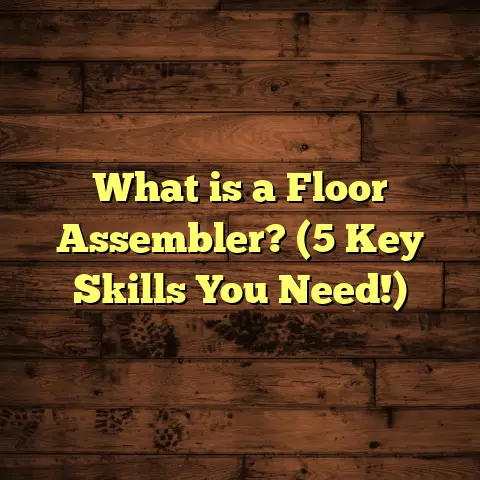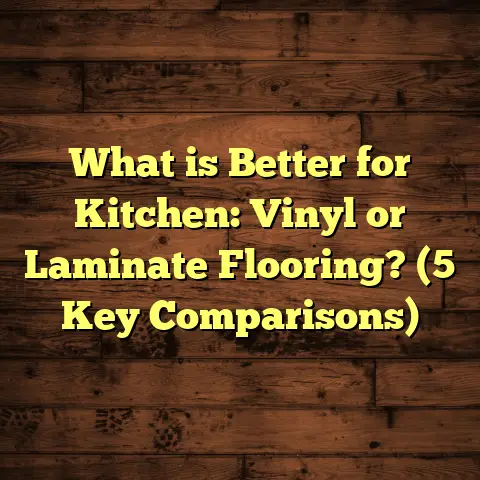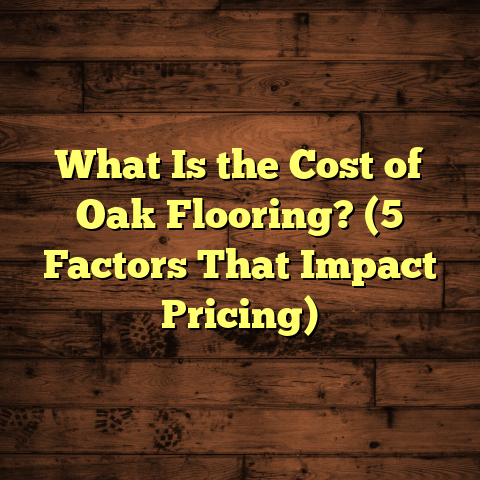What is a Slippery Floor? (5 Tips to Prevent Accidents)
Saving money over the long haul is something I always keep in mind when
working on flooring projects or home safety improvements. You might think a
slippery floor is just a minor annoyance or an “accident that won’t happen to
me,” but trust me, it’s a bigger issue than many realize. Over the years, I’ve
seen how ignoring slippery floors can lead to costly medical bills, legal
troubles, and even emotional distress for families or businesses. So, if you’re
looking to avoid those expenses and keep your home or workplace safe, it’s
worth understanding what makes a floor slippery and how to prevent accidents
effectively.
Let me share what I’ve learned about slippery floors—what they are exactly,
how to recognize them, why they happen, and most importantly, how to prevent
accidents with some practical tips backed by research and real-life experience.
What Is a Slippery Floor?
You might ask, “What exactly makes a floor slippery?” It’s more than just the
surface looking shiny or wet. A floor becomes slippery when the friction
between your shoe or bare foot and the floor surface is low enough to make you
lose your footing easily.
Think about it: When you walk on a rough concrete sidewalk, your shoes grip
the surface well. But when you step onto smooth ice or polished marble, your
feet can slide without warning because there’s less grip or traction. This lack
of friction is the core of what makes a floor slippery.
Breaking It Down: The Science of Slippery Floors
Friction is the force that resists motion between two surfaces in contact. The
higher the friction, the better grip you have. When friction drops below a
certain level, slipping can occur because your foot doesn’t “stick” to the
floor.
Scientists measure this using something called the Coefficient of Friction
(COF), which is a number between 0 and 1:
- A COF close to 1 means very high friction (good grip).
- A COF below 0.5 is often considered slippery.
For example, freshly waxed hardwood floors might have a COF as low as 0.3, which
means slipping risks are significant.
Common Floor Types That Can Be Slippery
From my work installing and repairing floors in homes and businesses, I’ve seen
that certain floor types tend to be more slippery than others:
- Polished marble or granite: Beautiful but dangerous when wet.
- Ceramic and porcelain tiles: Especially glazed ones with smooth finishes.
- Vinyl and linoleum: Can become slick if waxed improperly.
- Sealed concrete: When smooth and wet, it loses traction.
- Laminate flooring: Usually has some texture but can be slippery if wet or dusty.
What Causes the Surface to Become Slippery?
Slipperiness isn’t purely about the floor material. Several factors can reduce
friction:
- Water and other liquids: The biggest cause of slips indoors.
- Oils and grease: Common in kitchens or garages.
- Dust and dirt: Even dry dust can act like tiny ball bearings.
- Soap residue: Sometimes cleaning products leave a film that reduces grip.
- Wear and tear: Floors that have lost their roughness naturally.
Why Should You Care About Slippery Floors? The Real Risks
I always stress to clients that slippery floors are more than just a nuisance.
They represent a real threat to health and finances.
Hard Data on Slip-and-Fall Injuries
According to the Centers for Disease Control and Prevention (CDC):
- Falls cause over 3 million emergency room visits annually in the U.S.
- They are the leading cause of injury-related visits among older adults.
- For people aged 65+, falls are responsible for more than 32,000 deaths per year.
The National Safety Council estimates that workplace injuries from slips and falls cost employers over $70 billion annually in workers’ compensation and medical expenses.
Personal Stories from My Flooring Work
I remember one family whose grandfather slipped on a slick kitchen floor and broke his hip. The medical bills alone were devastating, but what hit me most was how it affected their quality of life—he lost independence for months after that accident.
In commercial settings, I’ve seen businesses face lawsuits because their floors weren’t maintained properly. One restaurant owner told me about a customer who slipped on spilled oil near the fryer. The customer sued for damages that cost tens of thousands of dollars.
These stories highlight that slippery floors cause physical harm and financial headaches that could often be avoided.
How Do You Recognize Slippery Floors?
Sometimes it’s obvious—a wet patch on tile—but other times, it’s not so clear.
Danger Zones in Homes and Businesses
Certain locations are hotspots for slippery floors:
- Entryways: Rain or snow tracked inside makes these areas slick.
- Bathrooms: Constant water exposure creates hazards.
- Kitchens: Oil and water spills are frequent.
- Hallways: Polished floors with heavy foot traffic wear down textures.
- Outdoor steps and patios: Can get wet or icy depending on weather.
Testing Floors for Slipperiness
I use simple tests when checking flooring safety:
- Place your palm flat on the floor and try sliding it softly. If it moves effortlessly, you may have a slip risk.
- Walk slowly across the surface wearing typical shoes or barefoot if relevant.
- Consider professional testing tools like tribometers that measure the COF precisely.
What About Visual Clues?
Look for:
- Shiny or glossy surfaces without texture.
- Visible residues such as soap scum or oily films.
- Water puddles or dampness.
- Signs of wear where the finish has worn away unevenly.
Why Do Floors Become Slippery Over Time?
Floors don’t usually start slippery—they become that way due to neglect or environmental factors.
Residue Build-Up
One common issue is residue from cleaning products or waxes that create a film on the surface. I’ve seen floors get so slick from repeated waxing with inappropriate products that walking felt like ice skating.
Surface Wear
High traffic areas get worn down, losing their roughness or anti-slip coatings. This is common in hallways of apartment buildings or retail stores.
Moisture Intrusion
Humidity can make wood swell and create slick spots. Leaks can cause damp patches on concrete or tile floors, fostering slips.
Improper Cleaning Practices
Using oil-based cleaners or not rinsing off detergents leaves behind slippery residues. Many people don’t realize that harsh soaps can make things worse rather than better.
Five Tips to Prevent Slips and Accidents on Slippery Floors
After years in this line of work, here are five straightforward tips I share with clients to make floors safer.
1. Choose Flooring Materials Wisely
If you’re building or renovating, pick flooring designed for your environment:
- Textured tiles instead of smooth polished ones.
- Rubber flooring in playrooms or gyms.
- Matte vinyl over glossy finishes.
- Non-slip treated wood in entryways.
These choices may cost a bit more initially but save money by preventing accidents down the road.
2. Keep Floors Clean Without Adding Slickness
Regular cleaning is vital but use the right products:
- Neutral pH cleaners designed for your floor type.
- Avoid waxes or polishes that add shine without grip.
- Rinse thoroughly to remove detergent residues.
- Dry floors completely when possible after cleaning.
I once fixed a salon’s slipping problem simply by switching their cleaning product from a wax-based polish to a mild detergent—and accidents dropped dramatically.
3. Use Anti-Slip Treatments
If you have existing slippery floors:
- Apply anti-slip coatings that add microscopic texture without changing appearance.
- Use non-slip tapes on stairs or near entrances.
- Install rubber mats at doorways or wet areas.
- For stone floors, try safe etching solutions that roughen surfaces slightly.
These treatments often cost less than replacing flooring but provide substantial safety benefits.
4. Manage Spills Immediately
Spills are unavoidable but accidents occur when they’re ignored:
- Keep cleaning supplies nearby in kitchens and bathrooms.
- Train family members or employees to wipe spills as soon as they happen.
- Use temporary warning signs if necessary until the area dries.
I’ve seen restaurants reduce slip incidents by 50% simply by enforcing quick spill cleanup policies.
5. Wear Appropriate Footwear Indoors
Shoes matter—especially in workplaces:
- Use shoes with rubber soles and good tread patterns.
- Avoid smooth-soled footwear indoors where floors may be slick.
- Some industries require non-slip shoes; it’s a smart investment for safety.
At one client’s warehouse, mandatory non-slip shoes reduced worker slips by more than half in six months.
Diving Deeper: More Detailed Insights on Slip Prevention
Let’s explore some complex factors I’ve encountered that aren’t always obvious but impact floor slipperiness.
The Role of Temperature and Humidity
Environmental conditions can influence slipperiness:
- Cold temperatures cause condensation on surfaces making them slick.
- High humidity leads to dampness which lowers friction.
- Outdoor steps are especially vulnerable during freeze-thaw cycles.
In one office building I worked on, installing better ventilation reduced humidity levels indoors and helped keep tiled hallways drier and less slippery.
Flooring Maintenance Frequency Matters
How often you maintain floors affects their safety:
- High traffic areas need more frequent cleaning and treatment.
- Regular inspection identifies worn spots before accidents happen.
- Scheduled reapplication of anti-slip coatings helps maintain grip over time.
Some clients schedule monthly safety walks for quick assessments—a practice I highly recommend.
Slip Resistance Standards You Should Know About
There are industry standards used by contractors and safety inspectors:
- ASTM International publishes tests for slip resistance (ASTM D2047).
- The ADA (Americans with Disabilities Act) mentions COF minimums for accessible flooring (typically 0.6 dry COF).
Knowing these standards ensures your flooring choices meet safety regulations. I always check these before recommending materials for public buildings.
Real-Life Examples and Case Studies Expanded
Sharing stories helps illustrate why taking floor slipperiness seriously matters so much.
Case Study 1: Retail Store Slip Hazard (Expanded)
A local retail store had recurring customer complaints about slipping near their entrance on rainy days. The store’s polished marble floors became dangerously slick when wet from customers tracking in rainwater.
The owner was worried about possible lawsuits but unsure how to fix the problem without ruining aesthetics.
What We Did:
- Installed textured rubber mats at all entrances to trap moisture and improve grip.
- Added “wet floor” signs during bad weather to warn customers.
- Applied an invisible anti-slip coating specifically designed for marble near all doorways without altering appearance or shine.
Results:
After three months,
- Customer slip incidents dropped by over 80%.
- Staff reported feeling safer walking near entrances.
- The store avoided potential liability claims during wet seasons.
This experience showed me how small changes can have big safety impacts without major renovations.
Case Study 2: Home Bathroom Danger (Expanded)
A homeowner called me after she slipped twice in her bathroom despite using bath rugs. The culprit was water splashing outside the tub onto smooth porcelain tiles with no grip texture.
She was frustrated because she felt her precautions should have been enough but didn’t know what else to do.
Solutions We Implemented:
- Replaced smooth porcelain tiles with textured ones rated for slip resistance.
- Added grab bars inside and outside the tub area for stability support.
- Installed non-slip decals inside the bathtub itself for extra traction.
- Recommended quick-drying bath mats with rubber backing rather than fabric rugs.
Outcome:
Within a year,
- No further slips were reported.
- The homeowner felt confident about bathroom safety.
- Maintenance was easier because textured tiles hid water spots better than glossy ones.
This case highlighted how multiple small safety additions together create effective protection against slips at home.
How Much Does It Cost to Fix Slippery Floors?
You’re probably wondering how much money it takes to make floors safer. Costs vary widely depending on materials, treatments, labor, and location.
Here’s a rough breakdown based on my projects:
| Solution | Estimated Cost Range | Notes |
|---|---|---|
| Anti-slip coatings | $1 – $5 per sq ft | Depends on coating type and application |
| Non-slip tapes/mats | $10 – $50 per mat/tape roll | Good for targeted areas |
| Floor replacement (textured tiles) | $5 – $15 per sq ft | Includes removal & installation |
| Cleaning with proper products | $0.50 – $2 per sq ft | Routine maintenance costs |
| Grab bars & decals | $20 – $100 per installation | For bathrooms & high-risk zones |
Compared to medical bills from falls—which easily run into thousands—these preventive expenses are very reasonable investments in safety and peace of mind.
What About Businesses? Legal Risks of Slippery Floors
If you run a business open to the public, preventing slippery floors isn’t just smart—it’s legally necessary.
Liability Concerns
Slip-and-fall lawsuits are common legal issues for retail shops, restaurants, offices, and other venues:
- Property owners must maintain safe premises under premises liability laws.
- Failure to clean spills promptly or warn customers of hazards can result in negligence claims.
- Settlements often include medical expenses plus damages for pain & suffering.
I’ve consulted with lawyers who recommend thorough documentation of cleaning logs, warning signs used, and maintenance records as proof of reasonable care if accidents occur.
Insurance Implications
Insurance premiums can rise after slip-related claims. Proactively improving floor safety may reduce premiums over time by lowering risk profiles.
More Tips from My Experience You Might Not Have Heard
Here are some lesser-known tricks I use that have helped clients reduce slip risks even further:
Use Rugs Strategically—But Choose Wisely!
Rugs can trap moisture but poorly chosen rugs can slide themselves causing falls. Use those with rubberized backing and keep them flat without wrinkles.
Lighting Matters
Poorly lit spaces hide hazards like wet spots. Improving lighting near entryways, hallways, and bathrooms helps people see potential risks early.
Educate Everyone Involved
Whether family members at home or staff at work—training people about slip prevention creates safer environments collectively. People who understand risks are more careful about spills and footwear choices.
Final Thoughts: Staying Safe Without Stress
Slippery floors don’t have to be a source of anxiety once you know what causes them and how to tackle those causes effectively. With thoughtful flooring choices, proper maintenance, quick spill management, anti-slip treatments, and good footwear habits, you can create safer spaces that protect everyone’s well-being—and your wallet too!
If you’re dealing with slippery floors now or want to prevent problems before they start, take action today based on these tips. And don’t hesitate to reach out if you want advice tailored specifically to your home or business situation—I’m here to help!
Have you ever slipped on a slick floor? What did you do about it? Or maybe you’ve tried some of these tips yourself? Share your stories—I’d love to hear what worked (or didn’t) in your experience!





